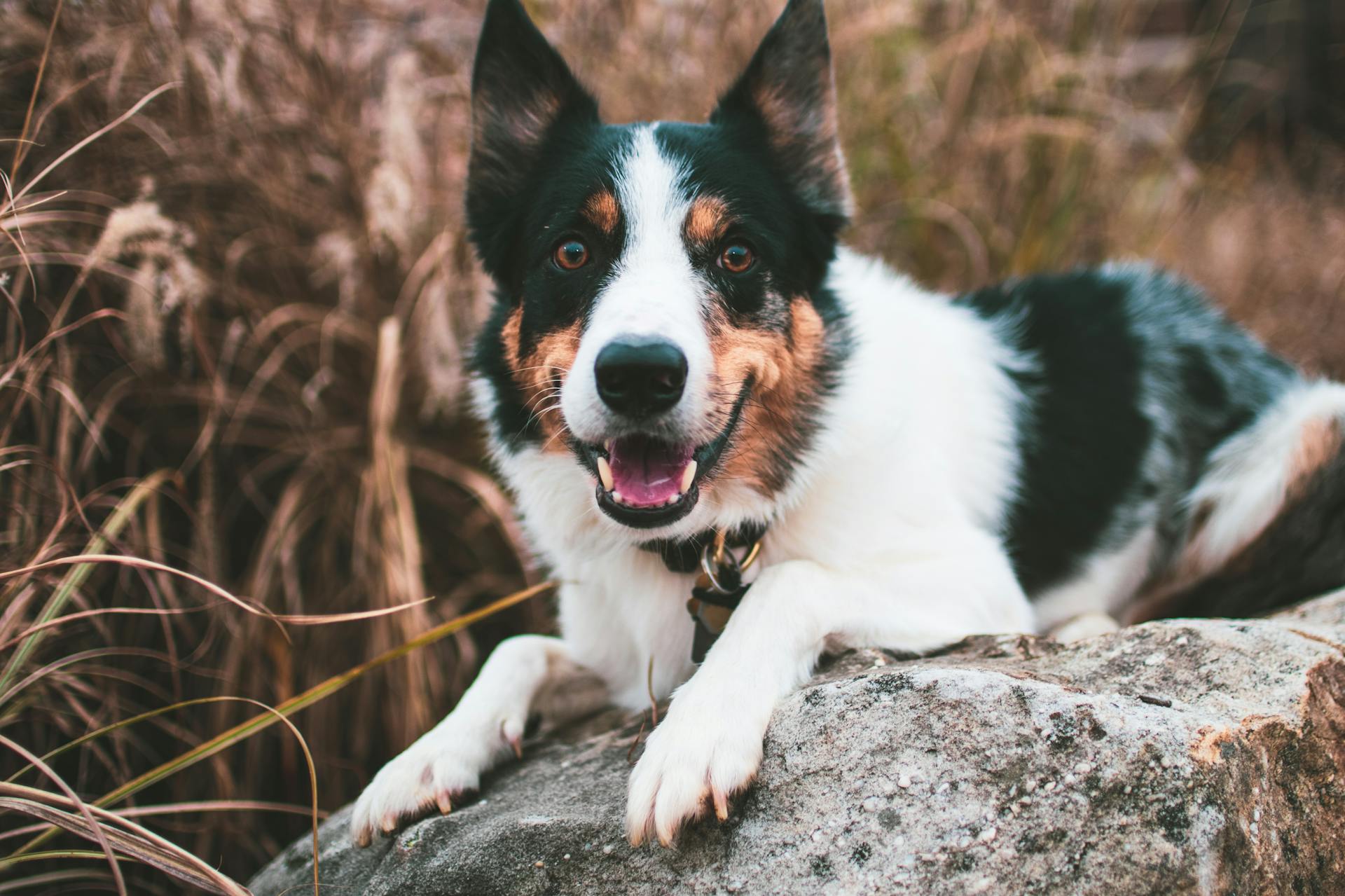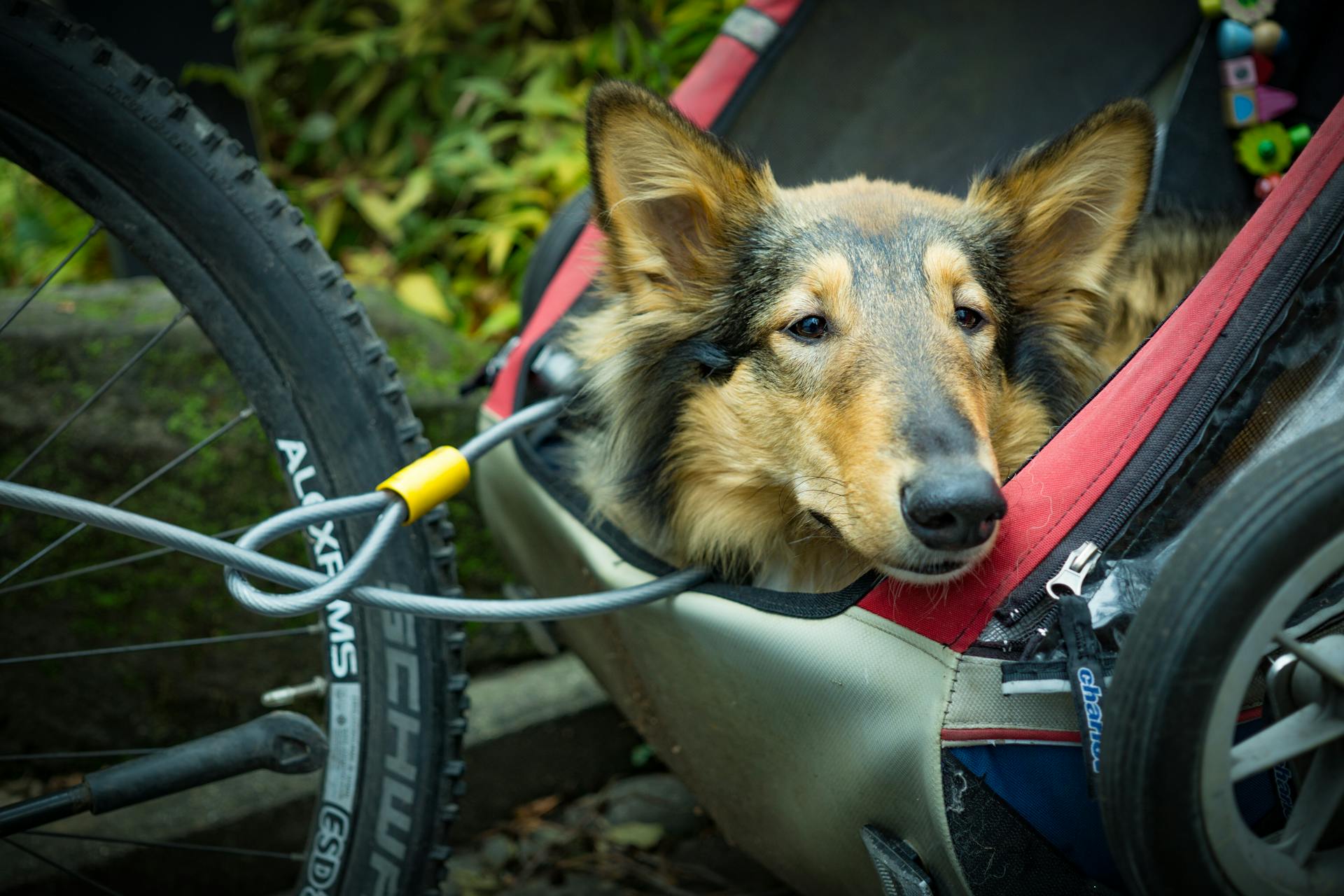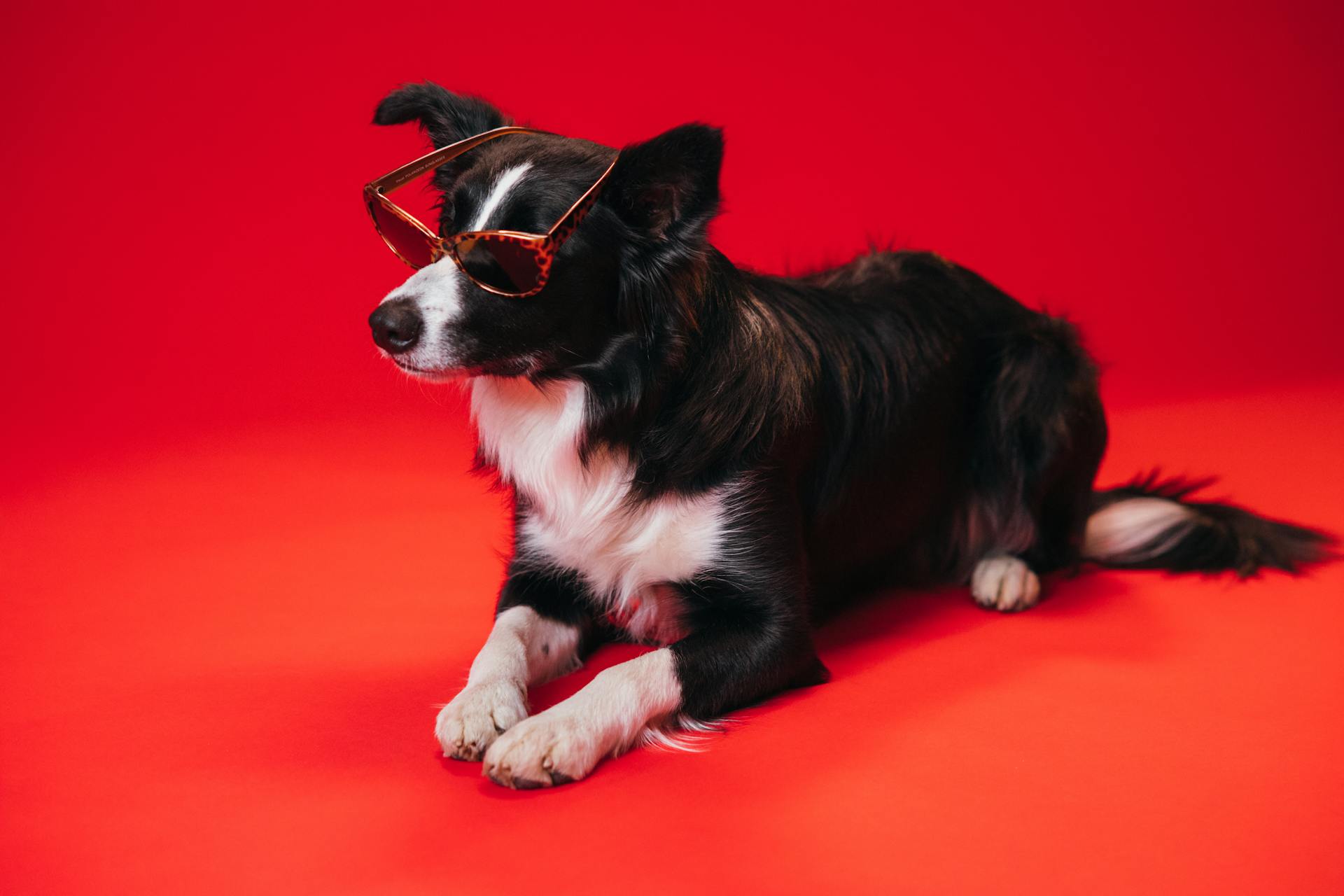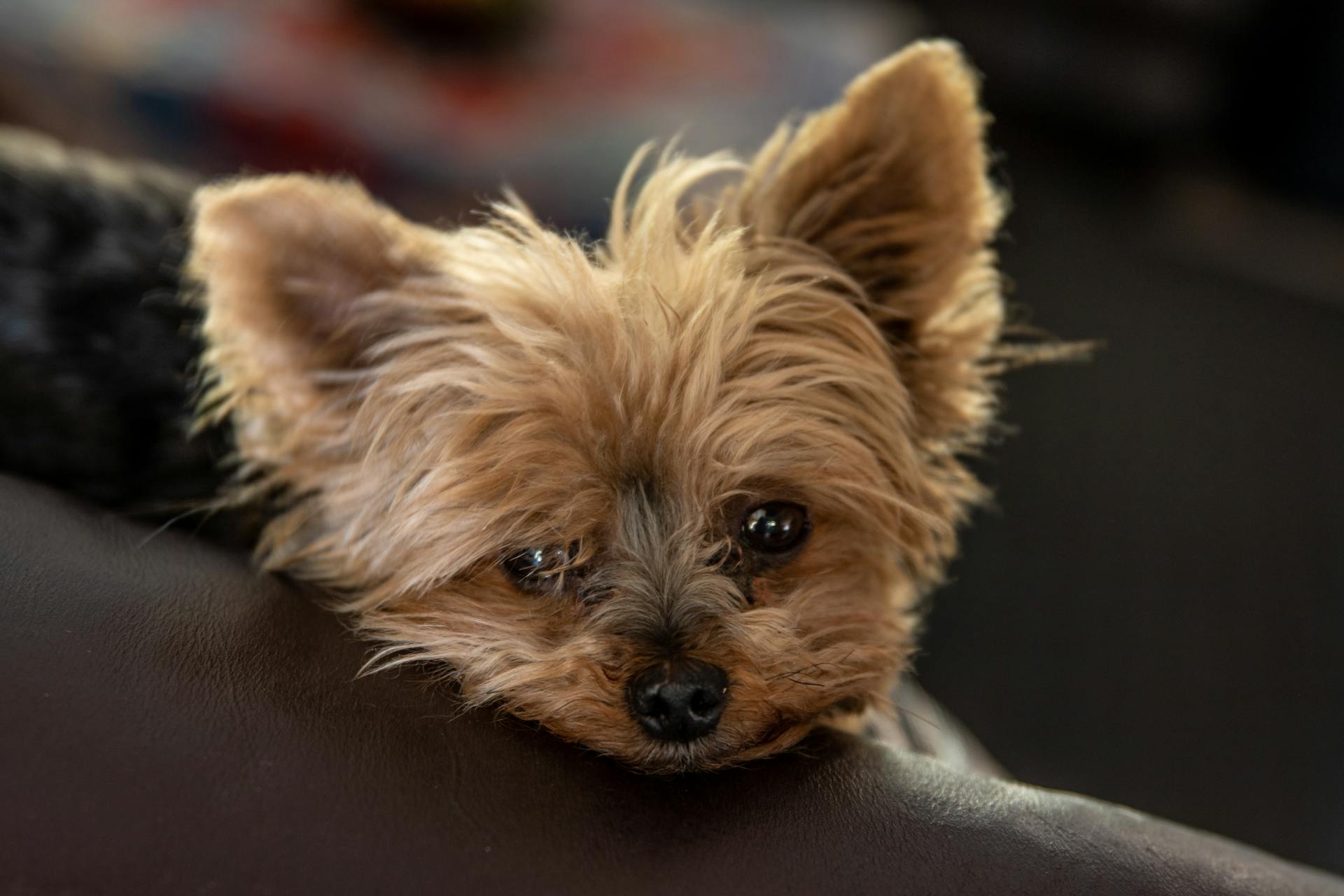
Border Collies are one of the most intelligent breeds around, ranking 1st in Stanley Coren's book "The Intelligence of Dogs". They're known for their high energy levels and strong herding instincts.
Their intelligence is matched by their physical agility - Border Collies can jump as high as 6 feet in a single leap.
Originating from the Anglo-Scottish border, this breed was bred to herd livestock for long periods of time.
You might like: Are Border Collies High Energy
Puppy Information
Border Collies are a popular breed that ranks in the top 50 of the American Kennel Club’s registered breeds.
If you're looking to bring one home, be aware that responsible breeders should provide genetic testing for their puppies.
You'll want to have plenty of toys on hand because Border Collie puppies are bound to be hyperactive and love to play.
A yard with space is essential to keep your little pup from racing laps in the house.
Getting a head start on obedience training can help burn off energy and prevent unruly behavior.
Are Remarkably Smart
Border Collies are remarkably smart, consistently ranking high in intelligence tests.
Stanley Coren, a canine neuropsychology professor at the University of British Columbia, named them the smartest of all dogs in his book "The Intelligence of Dogs."
They averaged an 82.4% passing rate with the American Temperament Test Society (ATTS), demonstrating their generally friendly and well-mannered nature.
Their intelligence makes them a delight to train, as they are clever and eager to please.
In fact, Border Collies are so smart that some dog experts believe they are one of the smartest breeds in the world!
Discover more: Why Border Collies Are so Smart
Care and Health
Border Collies are generally healthy dogs, but like all purebreds, they can be prone to certain health issues due to their genetic makeup.
Some common hereditary conditions in Border Collies include hip dysplasia, which occurs when a dog's hip joint doesn't develop properly, and epilepsy, one of the most common brain disorders that cause seizures in dogs. Epilepsy can be managed with medication, but it's essential to have your vet monitor your dog's condition closely.
Consider reading: Hip Dysplasia Bernese Mountain Dog
Border Collies also require regular grooming due to their double coat. They need to be groomed more than once a week, often more during the shedding seasons of spring and autumn. Minimal trimming around the back of the legs can help keep them looking tidy.
Here are some common health issues to watch out for in Border Collies:
- Trapped neutrophil syndrome (TNS), a fatal inherited autosomal disorder that compromises the immune system
- Hip dysplasia, a condition that occurs when a dog's hip joint doesn't develop properly
It's crucial to be aware of what signs of illnesses to look for so you can quickly address any health concern. Having Border Collie pet insurance can help reduce the stress of expensive vet bills and give you peace of mind knowing your four-legged friend is protected.
Common Health Problems
Border Collies are generally healthy dogs, but like all purebreds, they can be prone to certain health issues due to their genetic makeup.
Some common hereditary conditions in Border Collies include hip dysplasia, which occurs when a dog's hip joint doesn't develop properly.
See what others are reading: Hip Problems in Border Collies

Epilepsy is one of the most common brain disorders that cause seizures in dogs, and it's not strictly fatal but can be managed with medication.
Osteochondrosis (OCD) is another condition that affects Border Collies, causing abnormal growth of the cartilage on the end of a bone.
Collie eye anomaly (CEA) is an inherited disease that impairs vision, while progressive retinal atrophy (PRA) causes gradually progressive degeneration of the retina.
Trapped neutrophil syndrome is a fatal and incurable condition that usually affects Border Collies within the first few months of life, caused by a genetic mutation specific to this breed.
Here are some common health problems in Border Collies:
- Hip dysplasia
- Epilepsy
- Osteochondrosis (OCD)
- Collie eye anomaly (CEA)
- Progressive retinal atrophy (PRA)
- Trapped neutrophil syndrome (TNS)
It's essential to be aware of the signs of these illnesses so you can quickly address any health concerns and seek veterinary care if needed.
Grooming Requirements
Border Collies have a double coat that needs regular grooming, more than once a week.
They require brushing to keep their medium-length coats looking their best, and monthly bathing will keep their fur clean and free from matting.
During shedding seasons, they'll need daily brushing sessions to manage their excessive shedding.
Their nails don't need frequent trimming due to their high activity level, but it's still essential to trim them regularly.
Intriguing read: How Much Exercise Do Border Collies Need
Living with a Border Collie
Living with a Border Collie requires being an active owner who can provide plenty of attention and mental stimulation through activities like fetching a ball or herding livestock.
They are extremely energetic dogs that need lots of exercise to stay happy and healthy.
Owning a Border Collie is a huge responsibility, so make sure you know how to provide for their basic care needs before bringing one into your home.
Do Other Pets Get Along?
Border Collies can get along fine with other pets, but socialization is key.
Adequate training and socialization are necessary to ensure new animal arrivals go smoothly.
The Border Collie's herding instinct may cause tension if not checked, so it's essential to manage this trait.
With proper care, a household with multiple pets can be harmonious.
What Type of Owner
To live with a Border Collie, you need to be an active owner who can provide them with plenty of exercise and mental stimulation.
They love to run and need lots of attention from their owners, so if you're not someone who enjoys spending time outdoors or engaging in activities like herding livestock, this might not be the right breed for you.
Border Collies thrive on having a job to do, whether it's fetching a ball or performing tricks, so be prepared to keep them engaged and active throughout the day.
Owning a Border Collie is a huge responsibility that requires providing for their basic care needs, which can include regular exercise, training, and veterinary check-ups.
Physical Characteristics
Border Collies are a medium-sized breed, with males weighing around 45 pounds and females weighing about 42 pounds.
Their height varies slightly between males and females, with males reaching up to 22 inches tall and females standing as tall as 21 inches.
One of the distinctive features of Border Collies is their coat type, which can be either rough (feathered, medium-length) or smooth (coarse and short).
Discover more: How Tall Do Border Collies Get
Both types are double-coated and come in a wide range of colors with diverse markings, including blue, red, black, gold, lilac, slate, seal, brindle, sable, and many more.
Here is a list of some of the possible coat colors found in Border Collies:
- Blue
- Blue Merle
- Red
- Red Merle
- Black
- Gold
- Lilac
- Slate
- Seal
- Brindle
- Sable
- Sable Merle
- Saddleback Sable
- White Ticked
- White and Blue / Blue Merle
- White and Red / Red Merle
- White and Black
- White and Gold
- White and Seal
Their ears are perched high atop their heads and often folded over at the tip, adding to their distinctive appearance.
Characteristics
Physical characteristics can be quite fascinating.
The human body is made up of about 60% water, which affects our weight and overall health.
Our skin is the largest organ in the body and comes in various shades due to melanin production.
It's interesting to note that the average person sheds around 40 pounds of skin cells every year.
The eyes are a remarkable feature, with the iris containing pigmented cells called melanocytes.
A different take: English Bulldog Skin Issues
Physical Appearance
Border Collies are a medium-sized breed, with males weighing around 45 pounds and females tipping the scales at about 42 pounds.
Their height is also notable, with males reaching up to 22 inches tall and females standing as tall as 21 inches.
One way to tell a Border Collie apart from other breeds like Australian Shepherds is by their weight – they're generally lighter – and their longer, bushier tail.
The breed's body shape is slightly longer than it is tall, giving them a lean appearance.
Their ears are perched high atop their heads and often folded over at the tip, adding to their unique look.
Border Collies come in two types of coat: rough (feathered, medium-length) or smooth (coarse and short).
The longer-haired members of the breed often have a lush mane, which can be quite impressive.
Both types of coat are double-coated, meaning they have an undercoat and an outer layer that sheds water and provides insulation.
Border Collies come in an incredible range of colors with diverse markings:
- Blue
- Blue Merle
- Red
- Red Merle
- Black
- Gold
- Lilac
- Slate
- Seal
- Brindle
- Sable
- Sable Merle
- Saddleback Sable
- White Ticked
- White and Blue / Blue Merle
- White and Red / Red Merle
- White and Black
- White and Gold
- White and Seal
Training and Exercise
Border Collies are highly intelligent dogs that thrive on mental and physical stimulation.
They need tasks to complete and a lot of yard space to run around in, so be prepared for regular exercise sessions with your Border Collie.
Their high intelligence makes them quick learners, but they also require patience when training due to their strong herding instincts.
Early socialization is crucial to prevent shyness around strangers, and obedience training should start from an early age to provide enough mental stimulation.
Border Collies need at least two hours of vigorous exercise per day, which can be fulfilled through activities like agility training, fetch, or frisbee.
They respond well to praise and do very well in canine activities such as agility, herding, and obedience competitions.
These sporting activities are great ways to exercise your Border Collie's body and mind at the same time.
Take a look at this: Do Border Collies Need to Be Groomed
Food & Diet
Border Collies need high-quality food that meets their active lifestyle requirements.
They require a high-protein formula to sustain their energy levels throughout the day.
Discover more: Are Border Collies High Maintenance
A good idea is to look for a brand containing omega-3 fatty acids, which can support their joints and nourish their skin and coat.
You should consult your veterinarian to determine the best food type and volume for your Border Collie based on their size, age, activity level, and food brand.
Feeding them three-quarters to one full cup of dry dog food twice a day is a good starting point.
It's essential to provide fresh, clean water available at all times to keep them hydrated.
Keep an eye on your dog's calorie intake and adjust their feeding schedule accordingly if you notice weight gain.
Take a look at this: Best Food for Border Collies
Color Variations
Border Collies come in a variety of colors, and each kennel club has its own set of recognized colors.
The American Kennel Club recognizes 17 different standard colors for this breed, including black, blue, red, lilac, and more. The Canadian Kennel Club, on the other hand, allows virtually all Border Collie colors as long as white is not dominant.
Intriguing read: American Kennel Club Lancashire Heeler
Black and white is the most common coat color combination for Border Collies, with black bodies and white markings on their face and belly.
Here are some of the recognized colors by kennel clubs:
- AKC: Black, blue, red, lilac, sable, and more
- CKC: All colors except those with dominant white
Black tri-color Border Collies have black bodies with white markings and touches of tan on their chest, tail, legs, and cheeks.
20 Dog Breeds & Patterns
The world of dog breeds and patterns is a fascinating one, with so many unique combinations to explore.
The Beagle has a tri-color pattern, which means it has black, white, and tan markings on its coat.
The Dalmatian's distinctive spotted coat can be attributed to the breed's original purpose as a working dog, requiring high visibility in the smoke-filled stables of 18th-century England.
Greyhounds come in a variety of colors including brindle, fawn, black, blue, and red.
The Golden Retriever's luscious golden coat is due to its genetic makeup which codes for the production of eumelanin pigment.
Labradors are often found with a "black mask" on their face, but some individuals can have a liver or chocolate color instead.
Black and White

The classic black and white Border Collie is a staple of the breed, with many owners opting for this iconic color combination.
This coat pattern typically features a black body with white markings on the face and belly, making them easily recognizable as true Border Collies.
Their striking appearance has made them a favorite among dog enthusiasts worldwide, but it's also worth noting that this is the most common coat color for the breed.
Black Tri-Color
The Black Tri-Color is a beautiful and recognizable variation of the Border Collie breed.
This color expression is recessive, meaning both parents must have the gene to produce tri-color puppies.
Black Tri-Color dogs have black bodies with white markings that often include tan touches on their chest, tail, legs, and cheeks.
Dog Color Recognition by Kennel Clubs
The American Kennel Club recognizes 17 different standard colors for Border Collies, including black, blue, and red merle.
Each kennel club has its own set of recognized colors, so it's essential to check with your local club if you're planning to show or register your dog.
The Canadian Kennel Club is a bit more lenient, recognizing virtually all Border Collie colors as long as white isn't the dominant coat color.
Border Collies can have a wide range of colors and patterns, from solid to multi-colored coats.
Here are some of the standard colors recognized by kennel clubs:
- Black
- Blue
- Red
- Lilac
- Sable
- White and black
- White and blue
- White and red
Some colors, like white-ticked, are considered standard despite not being for everyone. White-ticked Border Collies have a two-color coat with small black specks on the white areas.
Red merle Border Collies have a rarer expression of the merle gene, resulting in potential health problems and light eyes, noses, and paws.
Frequently Asked Questions
Do Border Collies like to cuddle?
Yes, Border Collies are known for being affectionate and loving, making them a great match for those who enjoy cuddling with their pets. They thrive on attention and interaction, often seeking out physical contact with their owners.
Do Border Collies bark a lot?
Yes, Border Collies are known to be a barking breed due to their high visual stimulation. Their tendency to bark often requires proper training and management.
What are the behavioral issues of a Border Collie?
Border Collies are prone to behavioral issues like herding children, chewing, digging, and excessive barking when bored or frustrated. Proper training and mental stimulation can help prevent these problems.
Is A Border Collie a good family pet?
Yes, Border Collies are a great choice for families due to their loyal and affectionate nature. They thrive in active households with plenty of love and attention.
Is a Border Collie an indoor dog?
Border Collies are adaptable to indoor living but require regular outdoor exercise and mental stimulation. They're best suited for active owners who can provide a balance of indoor and outdoor activities.
Sources
Featured Images: pexels.com


